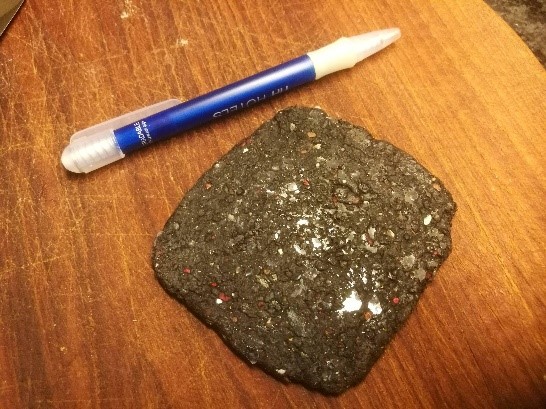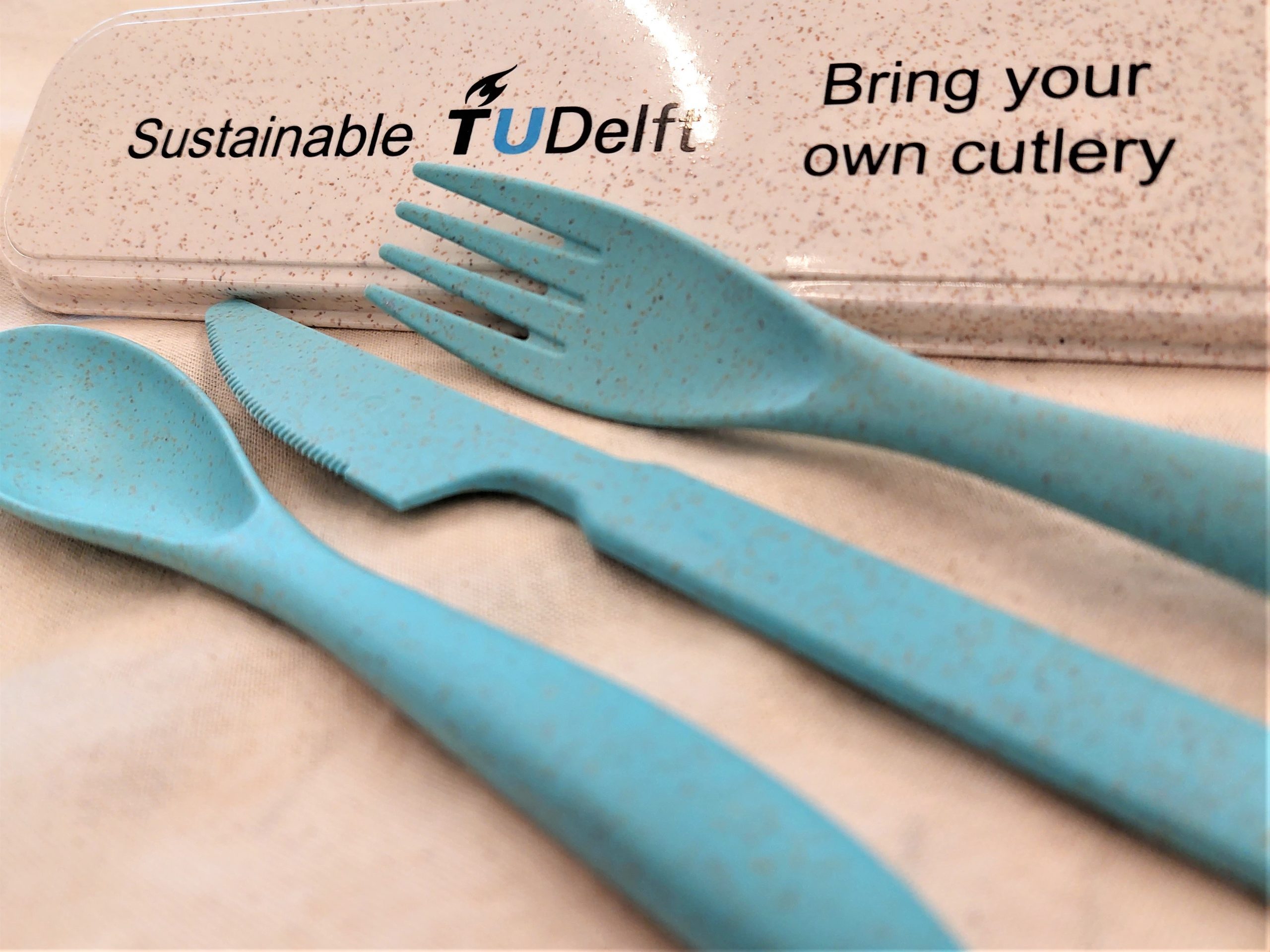Any students or staff members concerned about the blue cutlery sets can rest easy. The cutlery is safe to use even if its composition is not what TU Delft thought it was.
Professor Stephen Picken of Polymer Materials has his doubts about the amount of wheat straw (the brown dots) that are supposed to be in the cutlery sets. (Photo: Marjolein van der Veldt)
By Marjolein van der Veldt en Rob van der Wal
At the end of January all TU Delft students and staff could pick up a free, reusable set of cutlery at their local service desk. The set consisted of a blue spoon, fork and knife and the intention is to reduce the amount of disposable cutlery on campus. After they were handed out Delta received three critical emails from readers and Dap Hartmann wrote a column about it.
‘TU Delft cannot make it any clearer that it does not understand sustainability than through this initiative’ wrote one staff member. ‘There are two secondhand shops on the other side of the Schie that have containers full of metal cutlery that can be reused immediately. Instead, 30,000 sets were made in China and shipped to Delft in the name of sustainability.’
A few students question the safety of the cutlery. A similar set is being offered on Alibaba, the Chinese online department store. One concerned student stated that ‘There is no information available about the food safety of the material used. The packaging contains no information and no European certificate. I am very concerned about the health of my fellow students.’
Where was the cutlery produced, is it safe to use, and has TU Delft thought about sustainable alternatives? Delta delved into the issue. It was a long quest that involved the sustainability policy, laboratories and manufacturers in China.
1. Where was the cutlery produced?
The cutlery was purchased through a supplier called Van Slobbe Premiums & Gifts, said a TU Delft spokesperson. After questioning, we found out that the supplier had purchased them through a Chinese company called Global Bridge Industry Co. Ltd. It remains unclear whether the cutlery was produced by this company itself or if it obtained the cutlery from elsewhere.
2. Are the same sets of cutlery also sold through Alibaba?
The manufacturer of the TU Delft cutlery does indeed operate through Alibaba, and also has its own website and online shop.
3. What is the cutlery made of?
According to Sustainability TU Delft, 35% consists of wheat straw, the remains after the production of wheat.
When Delta asks him about the composition, Professor Stephen Picken of Polymer Materials expresses his doubts about this proportion. He believes that the amount of wheat straw is less than 10%. “Thirty percent wheat straw would make it really hard to process the plastic,” he says. “Furthermore, the product would not look like it is made primarily of plastic, as the cutlery does.” Picken sent a photo as evidence. “This is what an item with 30% fibres looks like.”

Plastic made of 30% fibre. (Photo: Stephen Picken)
According to Sustainability TU Delft the rest of the product consists of acrylonitrile butadiene styrene, or ABS, a strong hard plastic. Laboratory tests run by Picken’s colleagues, however, show that both the box and the cutlery is made of polypropylene, also known as PP. Delta was not able to find out the source of the plastic used in the cutlery. It could be made of oil, be biobased, or be recycled material. The packaging in which the boxes were wrapped is made of recycled cardboard that can be reused.
4. Is the cutlery safe to use?
“The cutlery was tested according to European guidelines and meet the standards,” says the TU Delft spokesperson. The cutlery sets have been CE certified, thus allowing the manufacturer to show that the product meets all European standards for safety, health, and environmental protection. This is also demonstrated in a test report. The TU Delft cutlery sets were tested and approved by the SGS, an international testing, inspection, and certification company.
5. Was this the most sustainable option or were other options also considered?
“We looked at alternatives,” says a TU Delft spokesperson. “We considered these cutlery sets as the most user friendly that would last several years – an important aspect in terms of sustainability. Other options, such as wood and bamboo, did not meet the criteria given their limited functionality and short lifespan.”
‘I use my set everywhere all the time’
Sustainability Coordinator Andy van den Dobbelsteen adds that they also looked at which option had the smallest environmental footprint. “Waste metal cutlery, as suggested by one of the people who emailed, would have led to all sorts of different types and sizes, and boxes would also have had to be specially made. Waste metal cutlery is now properly recycled in the metal industry. Melting metal waste and reworking it into new cutlery would have a huge environmental footprint. We considered all of these options before deciding on this cutlery set. These sets were designed so that everyone can carry them around all the time, making disposable cutlery redundant. This has an impact that goes far beyond the campus. I use my set everywhere all the time.”
The reusable cutlery sets will eventually replace the disposable cutlery in the canteens and restaurants on campus. “This will save thousands of kilos of waste every year and will allow us to reduce the CO2 emissions related to the production and processing of waste at TU Delft,” says the spokesperson.
In answer to the question whether major purchasing of products from China fits TU Delft’s vision of sustainability – in which local production is preferred – GreenTU, the student organisation, responds positively “The sets were shipped instead of being flown over and that makes a significant difference in CO2 emissions. In general, as much as possible is bought locally, but it is not always possible to get the desired price/quality ratio and meet the sustainability requirements. This is why not buying locally can sometimes be better. In these cases, we go for the most sustainable form of transport.”
According to Van den Dobbelsteen, the main starting point was that “TU Delft wanted to stop using disposable cutlery that would then be minimally processed”. His conclusion is that “This cutlery set may not be perfect but it is better than the huge mountain of disposable waste that we are now producing.”
To show how complicated it can be to obtain the right information, a summary of our research is listed below.
- Delta received the first email from a student on Thursday, 19 January 2023.
- On Friday 20 January we sought contact with the Food & More Department that was involved in this initiative through email and Instagram. They were not available by telephone.
- On Tuesday 24 January we received a response from a spokesperson that we could email our questions. We did so on Wednesday 25 January.
- We also sought contact with GreenTU, the student collective that is involved in making the campus more sustainable. At Delta’s request, they sent information about the composition of the cutlery sets on 25 January.
- On Tuesday 30 January we received an answer to our questions about the cutlery sets from the TU Delft spokesperson.
- As we were interested in the vision of GreenTU, we asked them for an additional response on Wednesday 31 January. They responded the same day. ‘GreenTU supports this initiative. We believe it is only logical that a news outlet like Delta is aware of how articles can be detrimental to sustainability initiatives. Criticism is always welcome when needed, but this campaign may not be the best target.’
- We asked Deirdre van Gameren, TU Delft Sustainability Project Leader how the Sustainability Steering Group views this initiative. She pointed us to the answers of the TU Delft spokesperson and GreenTU. The questions that we had submitted to them had been discussed by Van Gameren and her colleagues.
- On Tuesday 7 February we submitted the first version of the article to the TU Delft spokesperson with the request to fact check it. We also submitted an additional question about the composition of the cutlery. It was not clear to us whether it was made with ABS (as TU Delft announced) or of PP (according to the manufacturer).
- We received an answer on 9 February. Our question about the composition had not yet been answered.
- We received a response on 13 February. The answer (‘the composition of the material has been confirmed by the manufacturer’) was still not clear to us so we asked Professor Stephen Picken whether he could check the composition of the cutlery in a laboratory.
- On Thursday 16 February the lab found out that the cutlery sets were made of PP and not of ABS as stated by Sustainability TU Delft. Further research was needed to find out the amount of wheat straw.
- On Thursday 2 March, Picken informed us that his colleague had run tests, but that it was very difficult to find out the exact proportion of wheat straw. According to Picket, visually the composition looks less than 10% and he sent a photo of what 30% of fibres would look like.
- On Thursday 23 March we submitted the final version of the article to the TU Delft spokesperson.
- The article was published online on Thursday 30 March.



Comments are closed.